

You’re not alone if you’re scared of investing in the stock market. But this attitude is typical among those having minimal financial experience. Investing in the stock market is indeed quite risky, but at the same time, there is no better way to build up a person’s net worth if approached with complete knowledge and experience.
Introduction to the stock exchange begins with an understanding of what it is. In this article, we will guide you on the basics of the stock exchange and its various types.

What is a stock exchange?
Let’s proceed with the stock exchange definition; it acts as a secondary market, connecting stock sellers (existing shareholders) with potential buyers. Corporations listed on stock markets are not the real owners of their shares; instead, shareholders own them. It implies that whenever you purchase a share of stock, you don’t buy it from the company. You will buy it from the existing shareholder. On the same note, while selling your shares, you will sell them directly to the other investors, and the company has no concern over it.
There are various platforms for trading the shares or stocks of a company, known as stock exchanges. Although brokers are responsible for trading most stocks, you must understand the relationship between trading companies and stock exchanges and how they work. Moreover, every stock exchange has a unique set of requirements to protect its investors. So, let’s get into the trading procedure of the stock exchange.
How do stock exchanges work?
The stock market operates with several stock exchanges, of which you might have heard about the New York Stock Exchange and the Nasdaq. One of the major functions of stock exchanges is trading financial instruments, including bonds, equities, and commodities. The role of the stock exchange is to bring shareholders (investors), corporations listed on stock markets, and the government into one platform. They maintain liquidity in the market by ensuring enough sellers and buyers, thus making trade efficient.
Stock exchanges also help investors and financial professionals by providing them with the most accurate and fair financial information. This way, they make sure that the trading is being processed in a fair and orderly manner.
Stocks of any company are available on the stock exchange after the company lists its stocks through a process known as Initial Public Offering IPO. The shares are initially sold in a primary market to a set of initial public shareholders. This way, the company raises money for the expansion of its business. Once an IPO floats stocks to the public shareholders, they can be traded in secondary markets known as stock exchanges. There are many types of stock exchanges.
Auction exchanges
Auction exchanges just work like normal auctions. It is a stock market where sellers and buyers simultaneously offer competitive bids. The stock’s current price in an auction exchange is determined by what the buyer is willing to pay as his highest bid. However, the lowest price will be the lowest acceptable rate from the seller’s side. The deal is locked when both bids, by the seller and the buyer, are matched.
An auction market provides brokers and traders with an opportunity to communicate through physical and verbal signals on the trading floor. Stock exchanges are gradually shifting to electronic systems, but the auction system is still utilized by various stock exchanges, of which the New York Stock Exchange is a part. As the trading day ends, the closing auction determines the closing prices for all stocks involved in the auction.

New York stock exchange (NYSE)
Located in New York City, the New York Stock Exchange (NYSE) is the largest equity-based stock exchange in the world. Previously it was a private organization that came under public ownership after being acquired by the electronic trading exchange Archipelago in 2006. Following its merger with the most significant European stock exchange Euronext in 2007, it became known as NYSE Euronext. Since then, the Intercontinental Exchange, Inc (ICE) has owned NYSE stocks.
Since its inception as a public trading company, the NYSE was based on just floor trading. But now, NYSE has shifted some of its operations to electronic trading systems. However, the Designated Market Makers still have their physical presence on the trading floors. This makes the NYSE one of the leading auction markets in the world. Electronic exchanges pose a severe competitive threat to these professionals, as they are known for smaller bid-asks and fast trading by removing human intermediaries.
Being the first formalized US stock exchange, most of the old US-based public companies are listed on NYSE. To ensure the financial protection of its investors, NYSE has set initial listing requirements for the companies. That means every corporation must meet these initial requirements along with its compliance with the annual maintenance requirements. It is mandatory for each company to keep its share price above $4/share to continue trading. For a company whose security price closes below $1 for one month, the delisting process will be initiated against that company.
Electronic exchanges
Unlike auction exchanges, electronic exchanges offer all the trading on electronic platforms. no traders or brokers are present physically on the trading floor. Since everything is done electronically, these electronic exchanges eliminate the need for buyers and sellers to meet at a centralized location.
Electronic exchanges claim to conduct trading much faster and more efficiently than traditional auction exchanges. As buyers and sellers can participate virtually from anywhere, trading worth billions of dollars can be conducted in a single day. Most traditional stock exchanges are now shifting to electronic systems; Nasdaq is among the top electronic exchanges in the world.
The Nasdaq
The Nasdaq is among the well-known electronic exchanges worldwide that use telecommunication networks to connect buyers and sellers. Thus, it is called a screen-based exchange. Though not present physically, Nasdaq also has market makers which participate virtually with their inventory of stock. They post online bids and ask prices.
Just like NYSE, the Nasdaq also set some requirements to govern the credibility of companies listed on the Nasdaq. The minimum share price for a company is also $4 per share, in the case of Nasdaq., A company will be delisted to an OTC market if it fails to meet the requirements
Electronic Communication Networks (ECNs)
ECNs are the subclass of Alternative Trading Systems (ATSs). One of the distinguishing features of Electronic Communication Networks (ECNs), which make them popular among investors, is that they skip market makers or brokers. Buyers and sellers no longer need to purchase or sell their stocks through brokers, rather they can directly connect with the help of ECNs.
ECNs contribute much to lowering transaction costs, as they pose real competitive barriers to the other types of stock exchanges. As compared to individual investors, ECNs are more readily used by firms for investing a larger sum of smaller investors. Regarding ECNs, Arca Options and Nasdaq’s Interbank Network Electronic Transfer (INET) are the top priorities for investors.
Over-the-Counter (OTC)
To state simply, OTC markets are smaller markets as compared to the ones listed above. Likewise, smaller firms or organizations are listed in OTC markets, and the majority of them consist of those which have been delisted from organized stock exchanges like Nasdaq or NYSE. OTC markets have several types, of which the two most important ones are listed below:
- Over-the-Counter Bulletin Board (OTCBB) – It was an electronic platform having brokers that mostly comprised the companies delisted from Nasdaq. The platform had no requirement for listing like minimum sales or assets. However, it was closed in November 2021.
- Pink Sheets – This OTC provides the listing service without any requirement for the companies to get registered with Security and Exchange Commission (SEC). Moreover, these companies have relatively low liquidity.
Individual investors generally avoid OTC markets due to high risks. However, some of the larger firms are now shifting to OTC markets to save on costly fees and administrative burdens. As penny stocks trade over-the-counter, you should simply avoid them if you don’t have previous experience.
Other exchanges
A number of other stock exchanges are widely distributed over the world. Along with trading stocks, they are also involved in the digital currency exchange. Some of the well-known exchanges are listed below:
- Asia – More than 3800 companies are currently listed in TSE, and their combined market capitalization exceeds $5.6 trillion. The Shanghai Stock Exchange (SSE) and the Shenzhen Stock Exchange (SZSE) are the largest stock exchanges operating in China.
- Europe – The largest stock exchange in European countries is Euronext. It was formed due to the merger of three stock exchanges: Paris, Amsterdam, and Brussels, and since then, it has experienced multiple mergers. The second largest European stock exchange after Euronext is the UK-based London Stock Exchange (LSE).
- Digital Exchanges – Among the digital exchanges, Coinbase is ranked number 1. This US-based stock exchange provides a cryptocurrency trading facility for investors and institutions. Litecoin and Ethereum are the popular cryptocurrencies traded over Coinbase. Binance is another leading exchange platform for cryptocurrency trading, with a trade of over 2 billion per day. Previously, Binance didn’t allow USD funding but now deposits can be made using SWIFT transfer.
FAQs about stock exchanges
A stock exchange is a marketplace that brings together sellers and buyers to facilitate investment in stocks. But novice investors always have questions about its work. The below FAQ explains the functions of the stock exchange.
What is a simple definition of a stock exchange?
To state simply, the stock exchange serves as a platform connecting buyers and sellers to make trading efficient.
What are the three largest stock exchanges in the US?
According to the ranking, the largest stock exchange in the United States of America is the New York Stock Exchange (NYSE). It is also ranked number 1 in the global listing of stock exchanges. After that, the second largest stock exchange is Nasdaq, and the third position is occupied by American Stock Exchange.
What is the difference between the stock exchange and the stock market?
In simple words, a stock exchange is a platform or marketplace for equity trading (buying and selling of stocks). While the term stock market is used for all the stocks belonging to a specific country or area. You must also be aware of the biggest stock markets in the world.
What is the purpose of a stock exchange?
A stock exchange is meant to connect investors and companies. The company sells its stocks or shares to investors and raises capital which is then utilized to expand its business activities. On the other hand, investors are benefited from the profit made through these investments.
How many stock exchanges are in India?
According to SEBI, there are currently seven recognized stock exchanges in India. NSE and BSE are the most important ones. In addition, Calcutta Stock Exchange Ltd., Indian Commodity Exchange Ltd., Metropolitan Stock Exchange of India Ltd., Multi Commodity Exchange of India Ltd., and National Commodity & Derivatives Exchange Ltd. are available to brokers and investors.
Conclusion
Stock exchange meaning a place where all the stocks of leading companies are listed. Buyers and investors meet on this platform for efficient trading. The role of these stock exchanges is to protect the financial resources of both parties, the company, and the investors. Nasdaq and NYSE are the two biggest US stock exchanges (and also in the world). They ensure the credibility of the listed companies by setting requirements for them. It is mandatory for the companies to meet these requirements, otherwise, they can be delisted.
Although these are the largest stock exchanges in the world, they are not the only legitimate exchanges. ECNs are a relatively new concept in the stock exchange, but they will soon replace traditional exchanges. The OTC market serves as a great platform for highly experienced investors and companies as they can save costly fees, but certain risks are associated with it. Investing in a stock exchange is a great risk, especially for those who don’t have any prior knowledge or experience in this field. So, you must have some basic knowledge and understanding of foreign stock market trends before making an investment.









